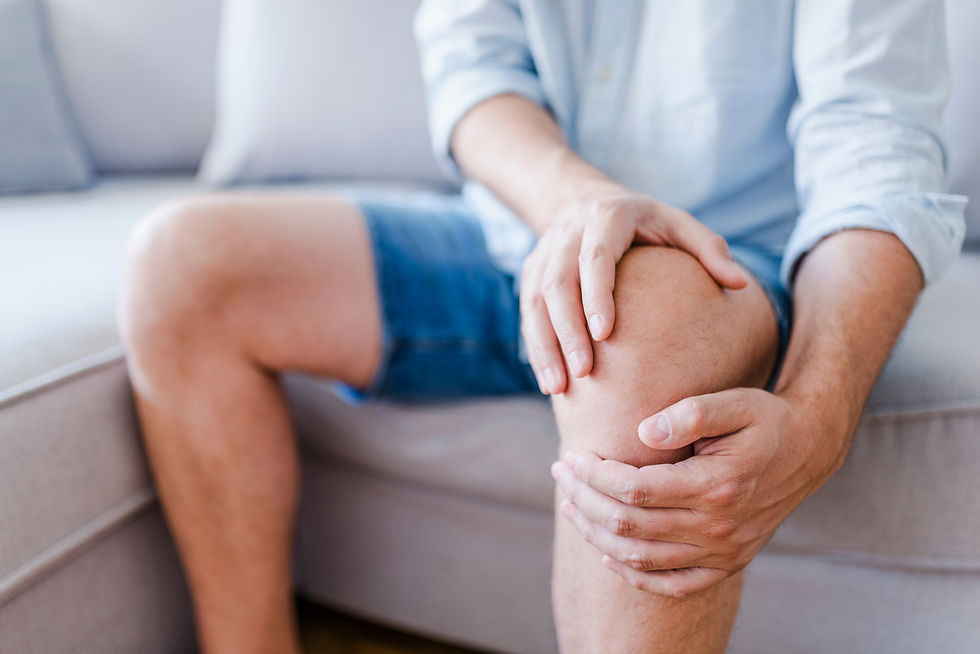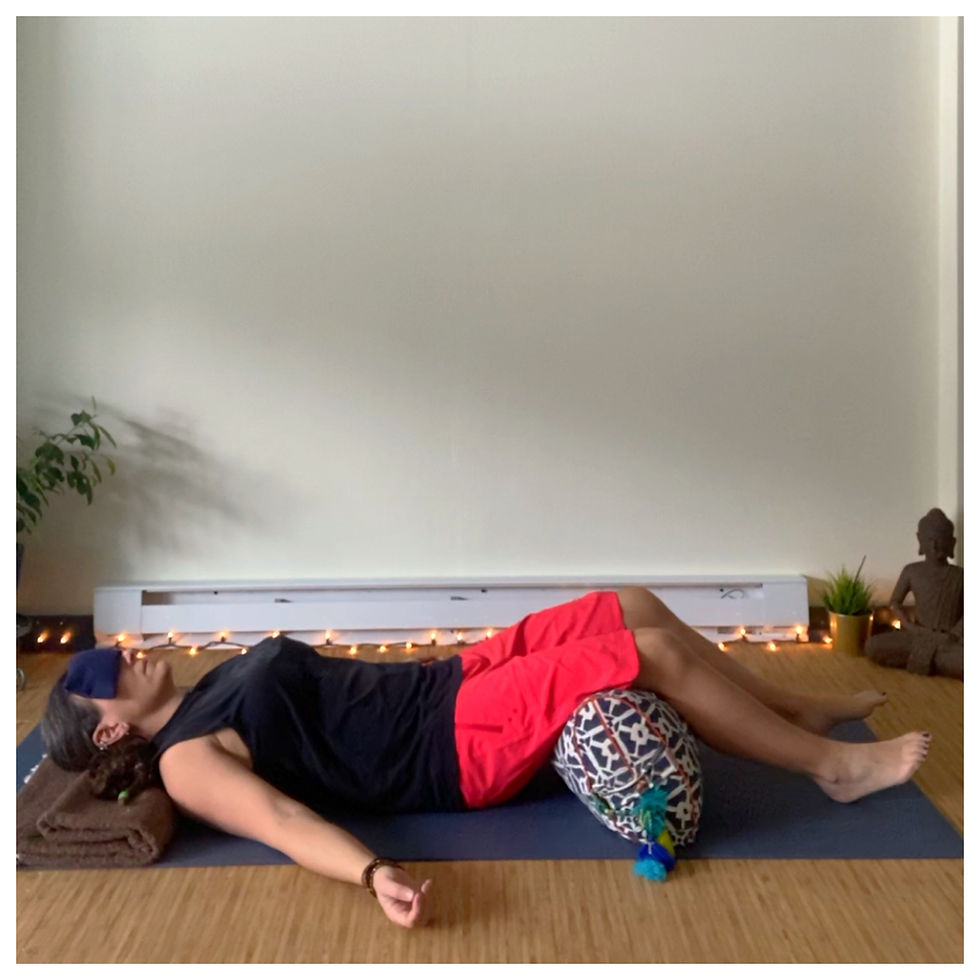Yoga for Osteoarthritis: Movement, Strength, & Relief
- Joy Zazzera

- Aug 4, 2021
- 4 min read
Updated: Aug 23
Living with osteoarthritis can feel like a constant negotiation between stiffness, pain, and the desire to move more freely. For many, the natural reaction is to avoid movement in hopes of reducing discomfort. Yet the opposite is true: gentle, intentional movement is one of the most effective tools we have for easing pain, building resilience, and supporting joint health.
I know this firsthand. My own not-so-straightforward experience with osteoarthritis began when I was just 36. A weakened knee joint had advanced to the point that even basic daily tasks—let alone my yoga practice—were significantly affected. For my age, the diagnosis felt unusual and unsettling, forcing me to rethink what “aging” meant. To me, it wasn’t about birthdays; it was about years of use, overuse, and inadequate recovery.
With few case studies of women facing total knee replacement before 40, my path forward was unclear. After a stressful stretch of trial and error, I found a surgeon who acknowledged my symptoms, recognized the severity of my condition, and compassionately mapped out a path that included two total knee replacements within 18 months. It was daunting, but his guidance gave me a way forward.

Why Yoga Supports Osteoarthritis: Pain, Flexibility & Function
Osteoarthritis (OA) is often invisible until you’re visibly compensating in movement or grimacing from pain. The early signs—clicking or crackling in the knees or hips—can be brushed off because cartilage itself has no nerve endings, meaning it can deteriorate silently for years. Eventually, as cartilage thins and bones begin to make contact, the pain becomes sharper, the inflammation more chronic, and the compensations harder to ignore.
This was my reality in my late 30s. By then, I was dealing with stabbing knee pain from all angles, constant inflammation, and mounting physical and emotional fatigue. Steroid injections failed to deliver lasting relief, and surgery became inevitable.
Here’s where yoga entered as more than a practice—it became a lifeline. Research shows yoga reduces pain and stiffness, improves joint function, and enhances quality of life for people with OA.
For me, yoga wasn’t just about stretching or strength—it gave me the mindset I needed: courage,
resilience, and the ability to embrace change with determination.
Gentle, Accessible Movement: Preparing for Surgery & Beyond
When I underwent my first replacement at 39, I’ll admit I did almost everything wrong. My stubbornness made the process grueling from start to finish. But by the time of my second surgery, I had learned from my mistakes. I used yoga, along with swimming, cycling, strength training, and diet changes, to prepare my body more intelligently. The difference was night and day—my recovery was smoother, more manageable, and far less painful.
This taught me what research continues to affirm: short, frequent, joint-conscious movement is more effective than sporadic intensity. Simple practices like Cat–Cow, supported Bridge, chair-based stretches, or mindful breathwork bring circulation and lubrication to joints, helping them move with greater ease.
Why Yoga Supports Osteoarthritis: Pain, Flexibility & Function
Research consistently shows that yoga can reduce pain and stiffness, improve joint function, and enhance quality of life in people with osteoarthritis. Gentle yoga practices encourage:
Increased mobility through low-impact range of motion
Stronger muscles that support and stabilize joints
Better balance and proprioception, reducing fall risk
Stress relief and nervous system regulation, which play a role in how pain is perceived
A 2024 randomized study even found that yoga participants with knee osteoarthritis reported reduced pain, better sleep, and improved function compared to controls.
Chair Yoga: A Gentle Path for Joint Pain Relief
If getting down to the floor feels daunting, chair yoga offers a safe and effective alternative. Studies show chair yoga helps older adults with osteoarthritis improve mobility, reduce stiffness, and enhance daily function.
From seated twists to supported forward folds, chair yoga provides all the benefits of yoga without the barrier of getting on and off the mat. For many of my clients—and even for myself post-surgery—chair yoga has been a bridge back to confidence in movement.

Yoga vs Strength Training for Knee Osteoarthritis
Strengthening exercises are often prescribed for OA, and they’re essential. But how does yoga compare?
A 2022 study found yoga to be non-inferior to strength training for adults with knee osteoarthritis.
While both reduced pain, yoga participants also experienced improvements in mood, function, and quality of life. For those who struggle with conventional exercise, yoga offers a joint-friendly, whole-body alternative that strengthens while also calming the nervous system.
Yoga Helps, But It’s Part of a Bigger Plan
My own recovery reminded me that yoga is powerful, but not a cure-all. I needed a team: surgery, physical therapy, cardiovascular conditioning, diet changes, and strength training. But what yoga gave me was unique: a practice that blended movement, stability, breath, and self-compassion into one accessible whole.
Where yoga shines is in its adaptability. You don’t need to force yourself into shapes that hurt or exhaust you. You simply need practices that meet you where you are.
Final Thoughts: Embracing Change with Grace
Osteoarthritis doesn’t follow a neat, predictable path. Symptoms, progression, and recovery all vary from person to person. For me, it was an unpredictable road that began in my 30s and led to two joint replacements before 40. For you, it might look different.
What I know is this: yoga gave me the tools to embrace change with resilience. It wasn’t the only form of movement I used, but it was the one that helped me listen inwardly, adapt with compassion, and rediscover joy in moving my body—even when it had changed dramatically.
You don’t have to be flexible, pain-free, or young to practice yoga. You just need curiosity, patience, and the willingness to start where you are.
.







Comments